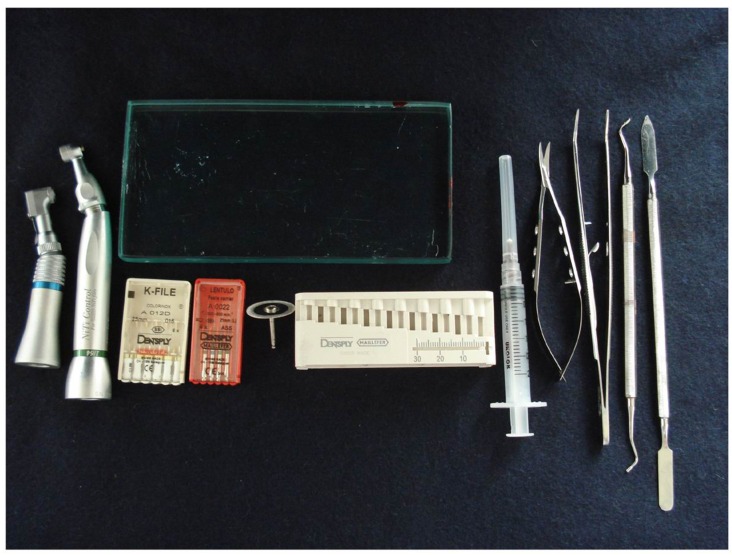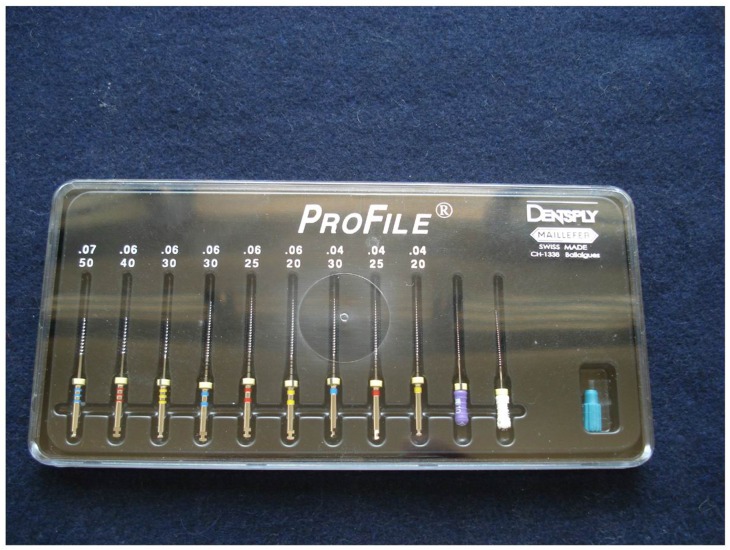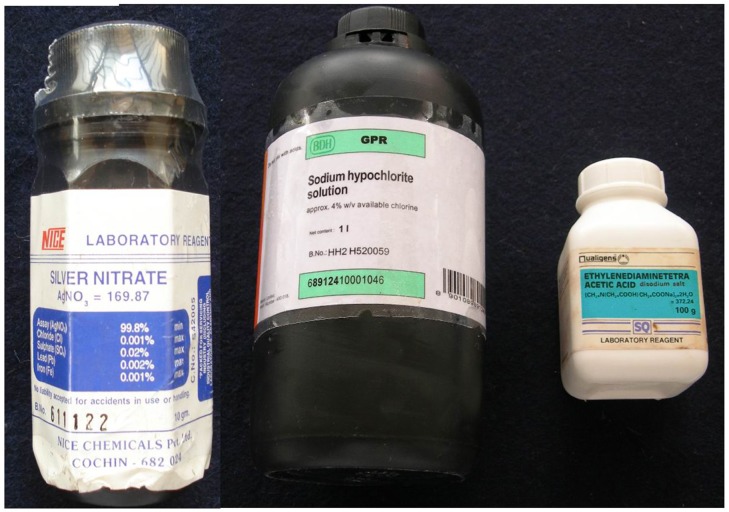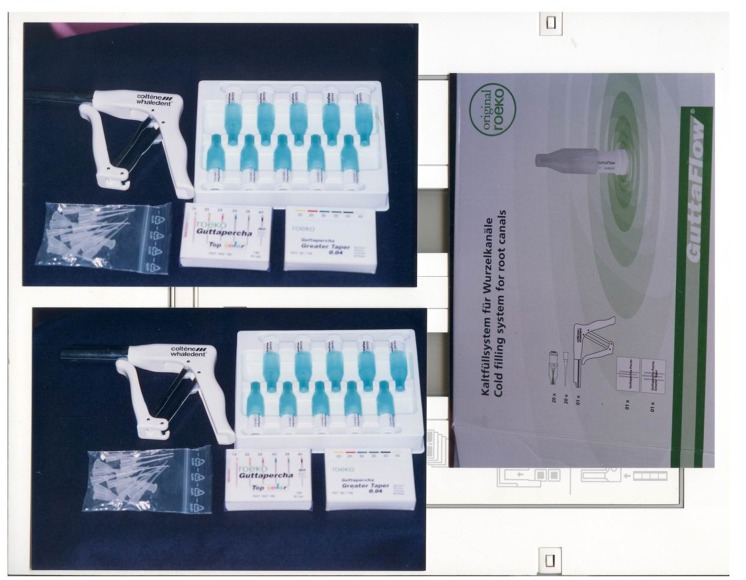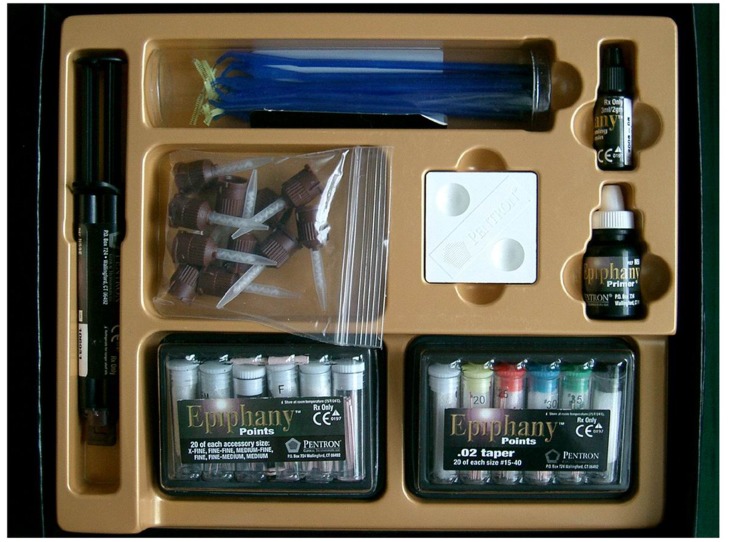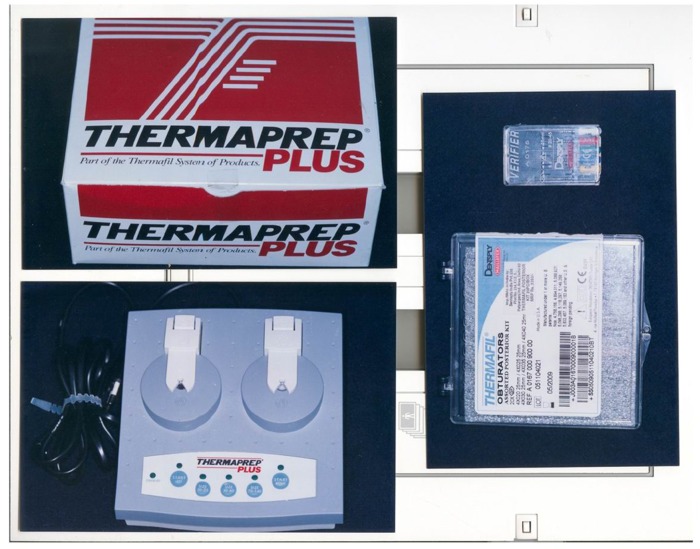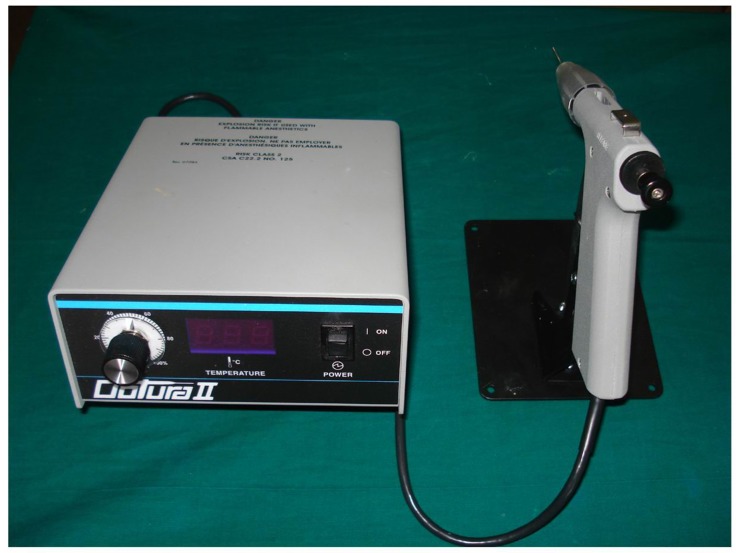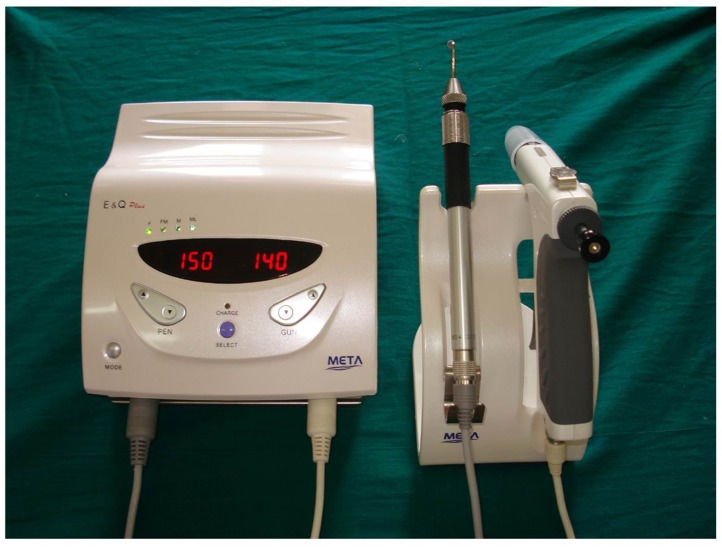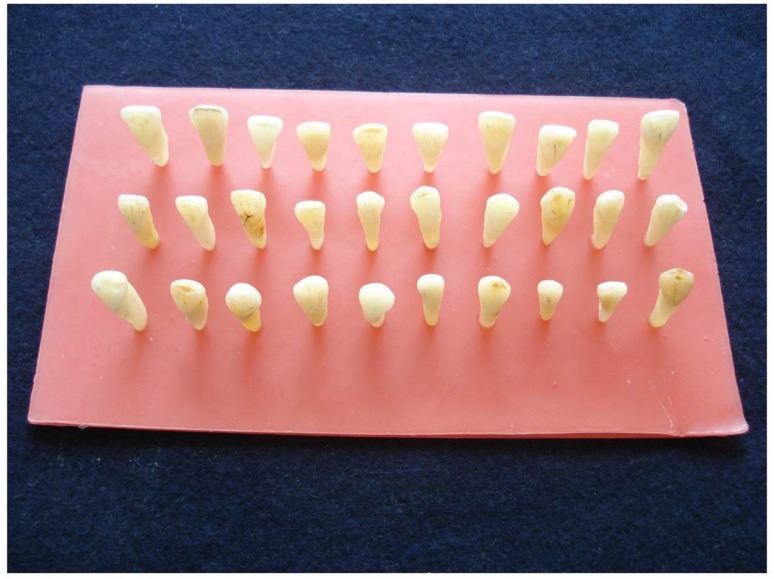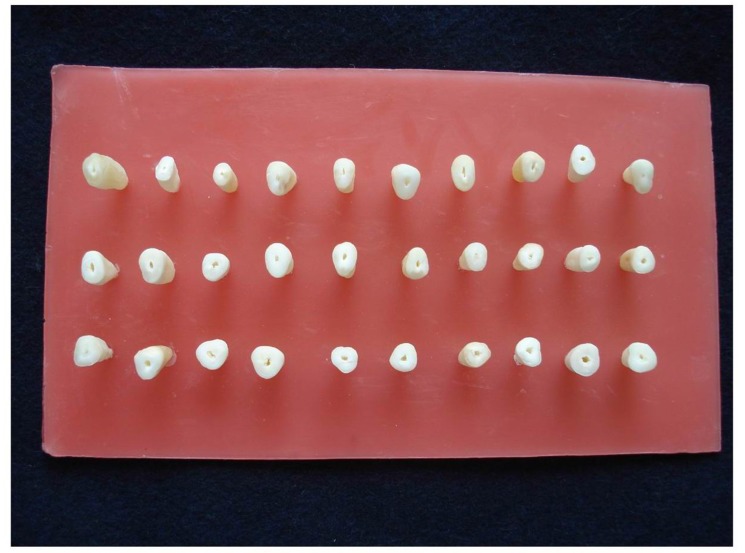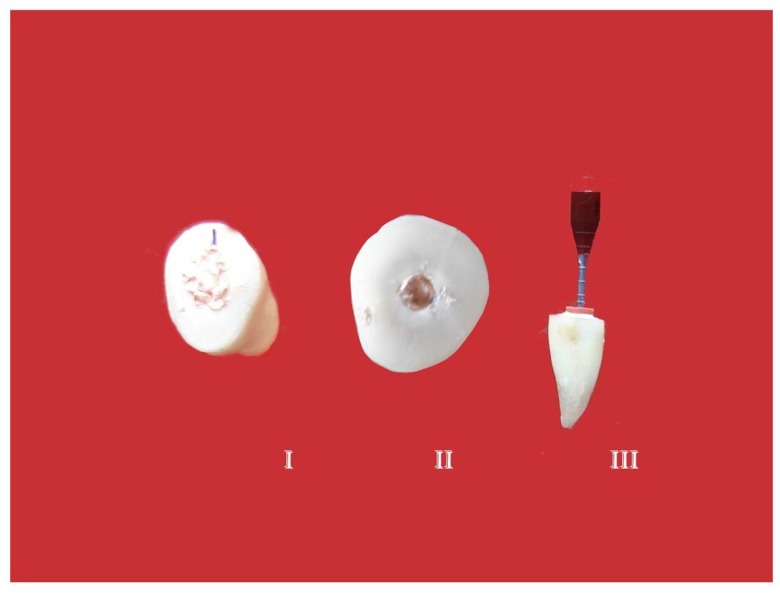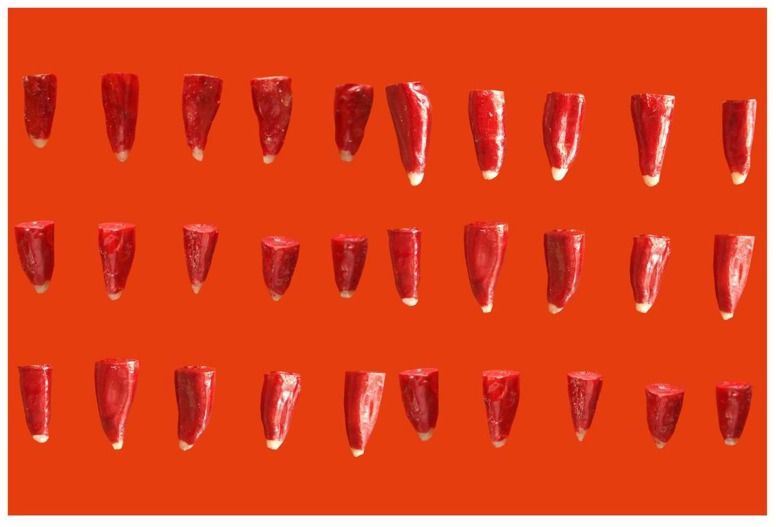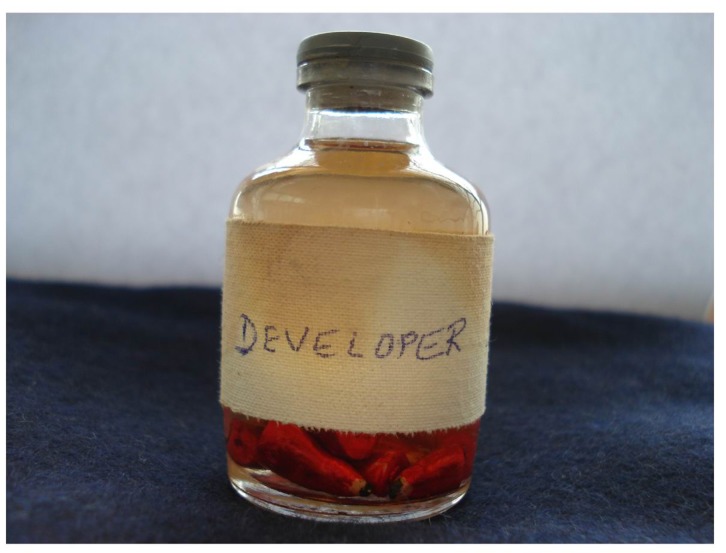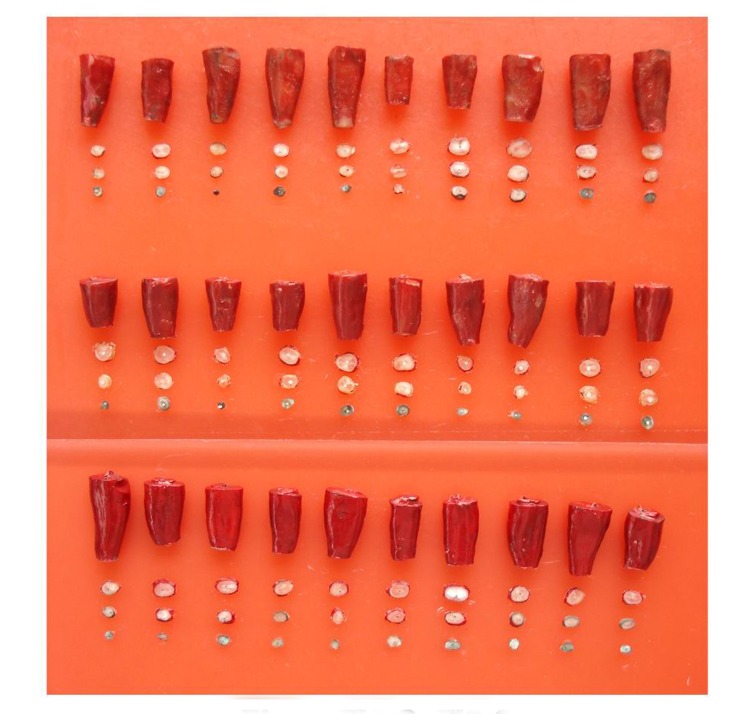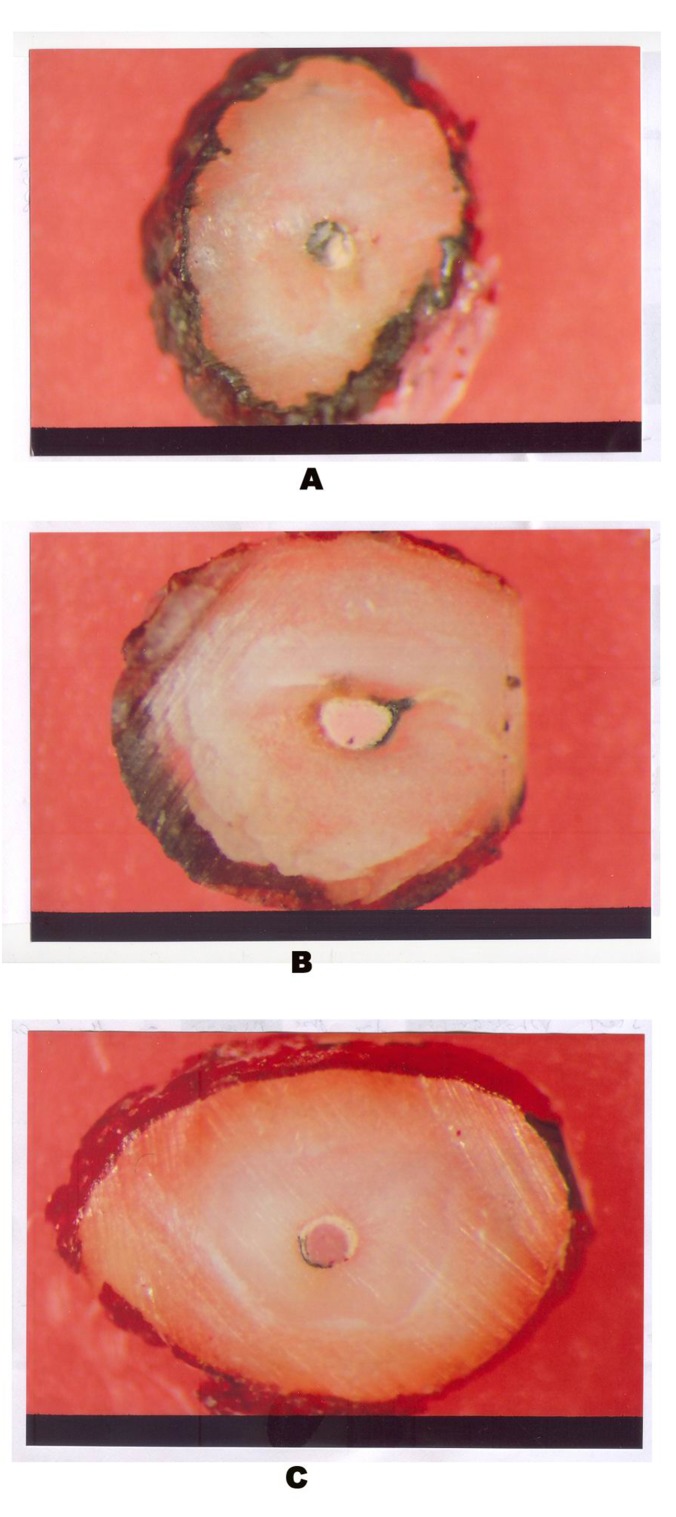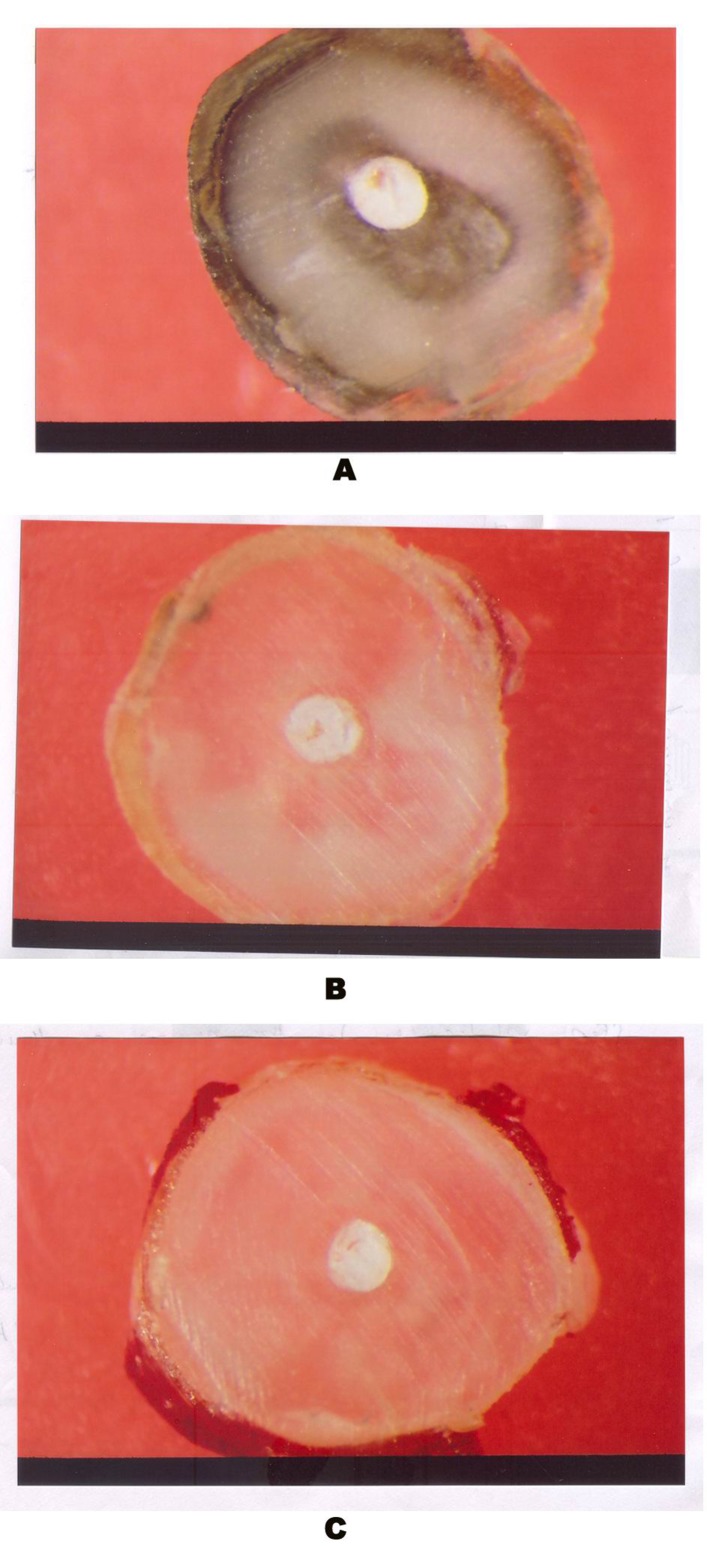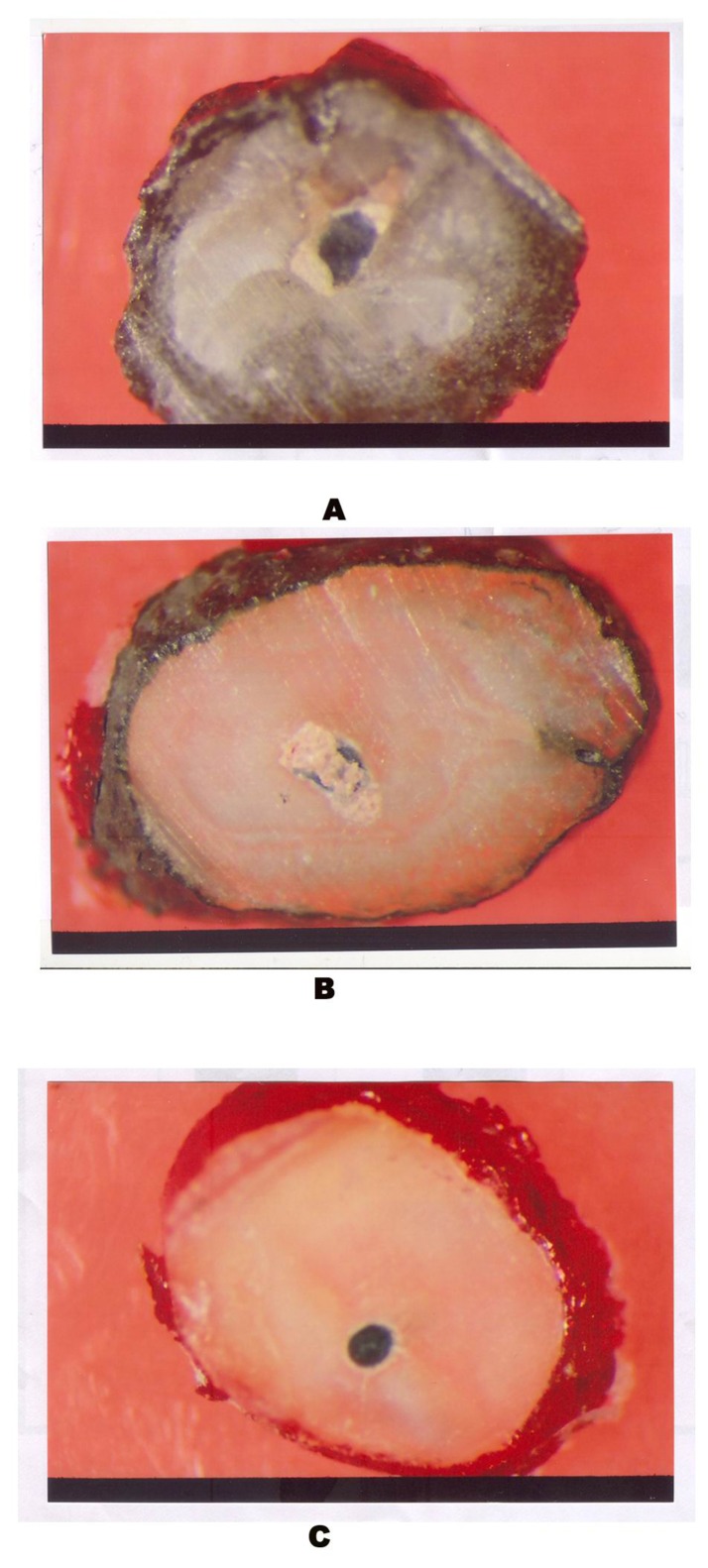Abstract
Introduction: Microleakage continues to be a main reason for failure of root canal treatment where the challenge has been to achieve an adequate seal between the internal structure and the main obturating material. The objective of this study is to compare the sealing ability of 3 newer obturating materials GuttaFlow, Resilon/Epiphany system (RES) and Thermafil, using silver nitrate dye and observing under stereomicroscope.
Methodology: Thirty single rooted teeth were divided into following groups. Group I : GuttaFlow ;Group II : Resilon /Epiphany sealer Group III : Thermafil with AH-Plus sealer. Teeth were decoronated and instrumented with profile rotary system and obturated with specified materials. Apical seal was determined by dye penetration method using silver nitrate. Then the specimens were transversely sectioned at each mm till 3 mm from the apex. Dye leakage was determined using stereomicroscope. Statistical analysis of the results was performed using Kruskall-Wallis test.
Results: The results showed that Group II i.e., Resilon with Epiphany sealer showed the least amount of microleakage when compared to Group I i.e., GuttaFlow and Group III i.e., Thermafil with AH-plus sealer. Conclusion: Based on the results of this study it can be concluded that RES had higher sealing ability followed by Thermafil and GuttaFlow in vitro but further studies have to be carried out to make a direct correlation between these results and invivo situation.
How to cite this article: Bhandi S H, Subhash T S. Comparative Evaluation of Sealing Ability of Three Newer Root Canal Obturating Materials Guttaflow, Resilon and Thermafil: An In Vitro Study. J Int Oral Health 2013; 5(1):54-65.
Keywords: : Apical microleakage, Silver nitrate dye, Profile rotary system, Stereomicroscope
Introduction
According to Ingle the most common causes of endodontic failure is incomplete obturation. He reported that 59% endodontic failure were due to leakage in the canal seal.1 According to Mannocci et al 1999 microleakage between root canal filling and root canal walls may adversely affect the results of root canal treatment. Therefore, complete obturation of the root canal with an inert filing material and creation of an apical seal have been proposed as goals for successful endodontic treatment by Nguyen in 1984.2
The three main functions of obturation are : i) To entomb any bacteria remaining in the root canal system. ii) To stop the influx of periapical tissue derived fluid from reentering the root canal iii) To prevent coronal leakage of bacteria. Although gutta-percha has many desirable properties it does not always bond to the internal tooth structure resulting in the absence of complete seal. This produces a poor barrier to bacterial microleakage and is considered to be one of the weakest points in root canal treatment.3
Fig. 1: Instruments used.
Fig. 2: Profile Rotary System.
Leakage through a filled root canal will take place along the sealer-dentin and sealer-root filling material interfaces or through voids within the sealer.4 Many attempts have been made to resolve this problem through variations in obturation technique including vertical and lateral compaction, use of reverse fill or touch and heat.5 Therefore, the advent of contemporary root canal sealing systems that claim to create bonds along the sealer – Gutta Percha interface via modification of sealer or root filling material or both has been in Vogue and requires time tested acceptance.6
Fig. 3: Materials used.
Fig. 4: Materials used.
Different endodontic filling materials and techniques have been introduced to the dental community in an attempt to improve apical seal. It is therefore important to assess the obturation quality of sealing material and leakage studies have been most commonly used. Many invitro methods have been used to evaluate the sealing ability of root canal filling materials by using dyes, scanning electron microscope, fluid-filtration technique, electrochemical methods, radio isotopes, bacterial studies and gas chromatography.7
According to Wu et al silver nitrate dye was used in the study because it presents greater clearness and contrast and better penetration due to smaller particle size. Its composition being Assay (AgNO3) – 99.8% minimum, chloride (Cl) – 0.001% Maximum, Sulphate (SO4) 0.02% maximum, Lead (Pb) – 0.002% maximum, Iron (Fe) – 0.001% maximum.6
A plethora of studies have indicated that microleakage whether from an apical or coronal direction adversely affects the success of root canal treatment. Many anatomical parameters and clinical considerations influence microleakage during the course of non surgical root canal treatment including root morphology, canal anatomy, patient cooperation, operator skill in preparation and obstruction of the canal and root canal sealing and filling material. The development and maintenance of a seal of the root system is considered to be a major prerequisite in success in root canal treatment. Therefore the evaluation of the quality of the root canal filling material using a variety of leakage tests to some degree is a relevant concept.8
Methodology
Thirty freshly extracted single rooted human teeth were selected for study on the basis of the following criteria, no root caries, resorption or fracture; mature, fully formed apices, single rooted and single canal, were stored in normal saline. Clinical crowns were sectioned at the cemento- enamel-junction with a low-speed diamond disc under continuous water spray.
Working length was established 1mm short of the apex. Instrumentation was performed with a crown down technique using profile Ni-Ti rotary instrument system according to specific set of instruments. All canals were prepared to ISO size 40, 0.06 taper. Canal patency was maintained by passing with an ISO size 15. K-file. Which was extended 1mm beyond the apex to maintain apical patency. The canal was irrigated between each instrument with 5.25% NaOCl and 17% EDTA alternatively. After completion of instrumentation, the root canals were dried with paper points and teeth were divided in to 3 groups of 10 teeth each randomly.
Group – I:
Teeth obturated with GuttaFlow. After the completion of the instrumentation, master cone was selected and the cone was coated with GuttaFlow and it was placed in the prepared canal, and rest of the root canal space was back filled with GuttaFlow.
Group – II : Warm vertical compaction of Resilon with Epiphany sealer.
Epiphany self-etching primer was introduced into the root canal with a micro-brush and excess primer was removed with paper points. A non-standardized Resilon master cone was tried in to within 1mm of working length. Epiphany sealer was then placed in to the root canal using a lentulo spiral, and the Resilon root canal filling material was down packed using the continuous wave condensation technique. (System B) at a reduced temperature of 1500 and a power setting of 10 as recommended by the manufacturers. Backfilling was performed with Obtura-II using 23 gauge needle tips at a temperature of 140°C. After backfilling, the coronal surface of the root filling was light-cured for 40sec. LED light curing unit was used to polymerize the surface of the dual-cured methacrylate sealer.
Group-III :
Thermafil Obturation Technique.
A size verification carrier No.40 reaching to the working length with no resistance or twisting was selected. AH plus was taken as a root canal sealer, and was mixed according to manufacture instructions. The sealer was coated to root canal walls, and the Thermafil obturators were heated in Thermaprep oven according to manufacturer instructions. The appropriate size of obturator was removed from the carrier wheel with care taken not to allow contact with the oven components. The oven opening was closed after each removal. Firm apical pressure was used to insert the Thermafil obturator to the previously determined working length. A round diamond bur in a hand piece was used to sever the plastic shaft; the rest was condensed vertically with an amalgam plugger.
After the completion of obturation all the teeth were stored for 24hrs for the proper setting of the sealer.
Apical Microleakage
Two coats of nail varnish with different colors were applied to the whole surface of each root except for 3mm from the apex. Teeth were then placed in a 50% weight silver nitrate solution for 1hr and kept in absence of light. Afterwards, these were rinsed in running distilled water for 1 min to remove the silver ions of the surface. Thereafter, they were immersed in a photo-developing solution and exposed to light for 12 hours. Teeth were then washed in distilled water and roots were transversely sectioned at each 1 mm of the root- end filling with a slow speed diamond disc. Sections resulted in three slices which were called A, B and C. Sections were considered first, second and third according to their distance from the apex. Each slice was divided into 4 equal parts and examined under stereomicroscope at X 30 magnification. Dye penetration was recorded and scored 0, 1, 2, 3 or 4 according to the amount of microleakage.
Fig. 5: GuttaFlow.
Statistical analysis of the results was performed using the Kruskall-Wallis test.
Results
Multiple group comparison was done using ANOVA, Mann-Whitney test and Kruskall-Wallis test were used to calculate 'p' value among different test groups. If p < 0.001 it indicates a significant difference among different groups.
The results showed that Group II i.e., Resilon with Epiphany sealer showed the least amount of microleakage when compared to Group I i.e., GuttaFlow and Group III i.e., Thermafil with AH-plus sealer.
This was followed by Group III which showed lesser microleakage when compared to Group I.
Discussion
The objective of operative endodontics is total debridement of the pulpal spaces, development of a fluid-tight seal at the apical foramen and total obturation of the root canal.
Fig. 6: Resion Epiphany System.
The purposes of obturating the prepared root canal space are well founded in the contemporary art and science of endodontology as simply stated are as follows -
Table 1: Group I - GuttaFlow Microleakage Scores.
| Gr I | |||
| No. of Teeth | A | B | C |
| 1 | 4 | 3 | 1 |
| 2 | 4 | 0 | 1 |
| 3 | 4 | 2 | 3 |
| 4 | 4 | 4 | 3 |
| 5 | 4 | 4 | 1 |
| 6 | 4 | 1 | 0 |
| 7 | 4 | 4 | 4 |
| 8 | 4 | 3 | 1 |
| 9 | 4 | 4 | 0 |
| 10 | 4 | 2 | 1 |
| Mean | 4.0 | 2.7 | 2.7 |
| SD | 0.0 | 1.4 | 1.4 |
| Median | 4 | 3 | 3 |
To eliminate all avenues of leakage from the oral cavity, all the irritants from periradicular tissues into the root canal system.
To seal within the system any irritants that cannot be fully removed during canal clearing and shaping procedures
The rationale for these objectives recognizes that microbial irritants and products of pulp tissue degeneration are the prime causes for pulpal demise and its subsequent extension into the peri-radicular tissue. Failure to eliminate these etiological factors and to prevent further irritation via continued contamination of the root canal system are the primary causes for failure of non-surgical and surgical root canal treatment. The clinician must choose a path of treatment that will result in the best possible cleaning and shaping of the root canal system coupled with an obturation technique that will provide a 3-D seal apically, laterally and coronally within the confines of the root canal system. If these technical parameters are achieved there is a high likelihood that the biological parameters of ultimate periradicular tissue regeneration will be achieved.9
Table 2: Group II - Resilon Epiphany System Microleakage Scores.
| Gr II | |||
| No. of Teeth | A | B | C |
| 1 | 4 | 4.0 | 0 |
| 2 | 4 | 0.0 | 0 |
| 3 | 4 | 4 | 0 |
| 4 | 4 | 4.0 | 1 |
| 5 | 4 | 0.0 | 0 |
| 6 | 4 | 4 | 0 |
| 7 | 4 | 4.0 | 0 |
| 8 | 4 | 0.0 | 0 |
| 9 | 4 | 4 | 0 |
| 10 | 4 | 4.0 | 0 |
| Mean | 4.0 | 0.9 | 0.1 |
| SD | 0.0 | 0.9 | 0.3 |
| Median | 4 | 1 | 0 |
Various endodontic materials have been advocated for obturation of the radicular space.
Grossman delineated ten requirements for an ideal root canal filling material.
Fig. 7: Thermafil.
Fig. 8: Triturator.
Fig. 9: Obtura II.
Fig. 10: System B.
Fig. 11: Light Emitting Diode.
Fig. 12: Stereomicroscope(LEICA WILD M-32).
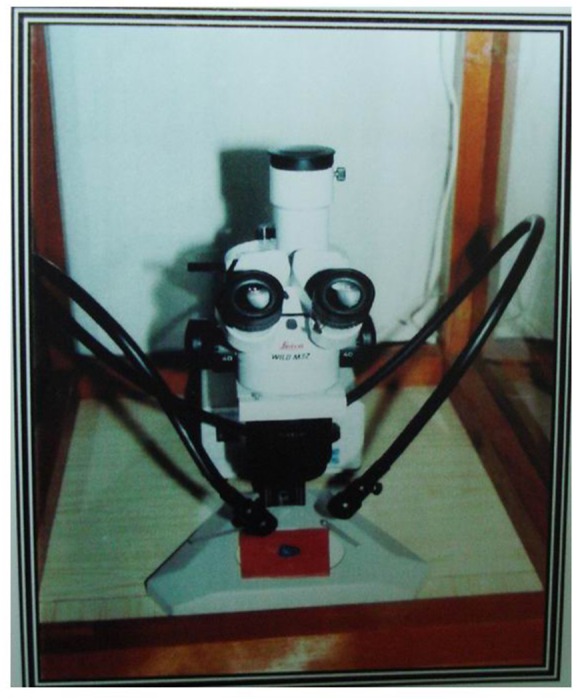
It should be easily introduced into the root canal.
It should seal the canal laterally as well as apically.
It should not shrink after being inserted.
It should be impervious to moisture.
It should be bacterostatic or atleast not encourage bacterial growth.
It should be radioopaque
It should not stain tooth structure
It should not irritate periradicular tissue.
It should be sterile or easily and quickly sterilizable immediately before insertion.
It should be removed easily from the root canal if necessary.10
Table 3 : Group III - Thermafil Obturation System Microleakage Scores.
| Gr III | |||
| No. of Teeth | A | B | C |
| 1 | 4 | 3 | 1.0 |
| 2 | 4 | 1 | 0.9 |
| 3 | 4 | 1 | 1 |
| 4 | 4 | 0 | 1.0 |
| 5 | 4 | 0 | 0.9 |
| 6 | 4 | 2 | 1 |
| 7 | 4 | 0 | 1.0 |
| 8 | 4 | 1 | 0.9 |
| 9 | 4 | 1 | 1 |
| 10 | 4 | 1 | 1.0 |
| Mean | 4.0 | 1.0 | 0.5 |
| SD | 0.0 | 0.9 | 0.5 |
| Median | 4 | 1 | 0.5 |
The sealing ability is a basic feature that needs to be tested for every new root canal filling material or technique. A new established silicon- based root canal filling material, GuttaFlow (Coltene Whaledent) was recently introduced in endodontic clinical practice. The new material is a modification of the RSA (RoekoSeal Automix) which has been shown to provide a consistent seal over a period of 18 months. According to the manufacturer GuttaFlow contains very small Gutta Percha particles in powder form, with a particle size of less than 30µm, and sealer in its mass.
Fig. 13: Extracted Single Rooted Teeth(30).
Fig. 14: Decoronated Teeth(30).
Fig. 15: Obturated Teeth from each Group GROUPS-I, II & III.
Fig. 16: Teeth Coated with Nail Varnish(30).
Fig. 17: Teeth in Developer Solution.
Furthermore, the manufacturer claims a better seal and good adaptability because of the increased flowability and the fact that this material expands slightly on setting. Also it has been shown that this material has and adequate adaptability to root canal walls. The properties of which has been improved by adding nano-silver particles and powdered GP to create guttaflow.7
Recent improvement in adhesive technology has led to the development of a new thermoplastic filled polymer that has a potential to challenge GP as a root canal filling material. The thermoplasticity of resilon is because of polycaprolactone, biodegradable polyester with a moderately low MP, while the bondability is derived from the inclusion of resin with methacryloxy groups. This material also contains glass fillers and barium chloride or fillers and is capable of coupling to resin sealers, an e.g. of which is epiphany (Pentron clinical technologies). Epiphany root canal sealant is a dual curable resin composite containing a new redox catalyst, that enables optimal autopolymerization under acidic environments.11
Fig. 18: Sections.
Thermafil (Dentsply Tulsa dental) was introduced as a GP obturation material with a solid core originally manufactured with a metal core and a coating of GP, the carries was heated over an open flame. The technique was popular since the central core provided a rigid mechanism to facilitate the placement of the GP. Advantages were ease of placement and pliable properties of GP. Disadvantages were that the metallic core made placement of a post challenging and retreatment procedures were difficult. In addition, the GP was often stripped from the carrier leaving the carrier as the obturating material in the apical area of the canal. Recent changes in the carrier system include, development of the plastic core coated with a phase GP and heating device that controls the temperature. Obturators are designed to correspond to the ISO standardized file sizes, variable tapered Ni-Ti rotary files and the GT profiles Ni-Ti rotary files. Size verifiers are available to aid in selection of the appropriate carrier and should fit passively at the corrected working length.9
Fig. 19:GuttaFlow – Section A, B & C.
Hence these three materials were used in this study; they were tried, tested and compared.
Fig. 20:Resilon – Section A, B & C.
Results of group I have shown that there wasincrease amount of microleakage in all the sections. GP has been reported to expand slightly on setting.4 a study has shown that GuttaFlow technique showed a similar sealing ability to lateral compaction or system 'B' technique when evaluated at 3 and 6 months after obturation. However, at 12 months root canal fillings with GuttaFlow leaked significantly less than fillings of lateral compaction and system 'B' technique. These findings may be related to the possible responding capacity of the material.7
Fig. 21:Thermafil – Section A, B & C.
Our results showed that the RES appears to be superior to thermafil and GuttaFlow in apical sealing. The results obtained from the Resilon epiphany system may be attributed to the monoblock provided by the adhesion of the filling material to the sealer which also adheres and penetrates into the dentin wall of the root canal system.12
The configuration factors is defined as the ratio of bonded to unbonded surface areas of cavities in a root canal is highly unfavourable and contributes to maximizing the polymerization stress to resin based materials along the root canal walls. However, despite these problems the results of this present study indicate that Resilon with epiphany sealer had the least amount of microleakage at 2mm and 1mm.13
The results of this present study are supported by similar results carried out by other studies. 14, 15
Results for group III in the present study showed that there was greater microleakage in the thermafil group as compared to RES, but the statistical values were not significant.
Thermafil technique resulted in root canal fillings that adapted well to the canal walls as shown by previous studies which would have resulted in the less amount of microleakage seen.16
In addition it has been shown by previous studies that AH-Plus is reported to expand slightly during setting resulting in lower leakage. Infact, AH-Plus is a gold standard against which newer sealer are evaluated.4 Properties of AH-Plus sealer are long-term sealing, dimensionally stable, self adhesive properties and very high radiopacity.
Working time is minimum 4 hrs at 23°C and setting time is minimum 8 hrs at 37°C.
In the design of this study it could be argued that the leakage which has occurred may be a function of a sealer. And many studies have shown that canal irregularities were filled with both the sealer and gutta-percha with the thermafil technique demonstrating greater GP adaptation to the intricacies of the root canal system.17 According to other similar studies the leakage exhibited in the apical 1mm could be attributed to a small degree of under extension of GP in these teeth.18 It is also been seen that the use of thermoplastized GP in a canal with possibility of post-operative discomfort and delayed periapical healing. It is unknown what effect the cooling of molten GP has upon the sealing ability of this technique, results of different investigations have indicated that a solid plug is necessary at the root canal foramen to prevent over extension when using heat softened GP as a root canal filling material.19
Studies have shown that there was no significant difference in sealing ability of thermafil obturators compared with cold lateral compaction of GP as long as sealer was used. This observation agrees with other studies indicating that a root canal sealer is essential. Although the shrinkage of thermoplasticized GP associated with GP phase transformation is well known the presence of sealer can obviously help offset any contraction of the thermafil GP mass.20
The apical 5-6mm of root canal is a critical area of placement of sealer and is important for successful obturation. Particular attention must be given to the evaluation of sealer placement in that region, because it is in this area that accessory canals are most often formed. Studies have shown that use of bi-directional spirals to coat the walls. With sealer results in more efficient seal by increasing cement interface.
In this study as only lentilo spirals have been used to coat the sealer to the root canal walls and bi-directional spiral were not used, the sealing effect could have been less. And would probably have been better if bi-directional spirals were used.21
Maximum leakage was seen in section A for all the groups which may be because of the fact that apical patency was confirmed by use of No.15 K-file 1mm beyond the apex and obturation was intently done 1mm short of apex which is the safety factor to establish minor foramen, which was probably the reason for maximum microleakage.
The singular goal of obturation is to "Seal to Heal – Blocking All Evil Portals".
Conclusion
Based on the results of this study it can be concluded that RES had higher sealing ability followed by Thermafil and GuttaFlow in vitro but further studies have to be carried out to make a direct correlation between these results and invivo situation.
Footnotes
Source of Support: Nil
Conflict of Interest: None Declared
Contributor Information
Shilpa H Bhandi, Department of Conservative Dentistry and Endodontics, M S Ramaiah Dental College and Hospital, Bangalore, India.
Subhash T S, Department of Dentistry MMC & RI, K. R. Hospital, Mysore, Karnataka, India.
References
- 1.Hata G, Kawazoe S, Toda T, Weine FS. Sealing ability of thermafil with and without sealer. J Endod. 1992;118(7):322–326. doi: 10.1016/s0099-2399(06)80481-4. [DOI] [PubMed] [Google Scholar]
- 2.Cobankara FK, Adanir N, Belli S, Pashley DH. A quantitative evaluation of apical leakage of four root-canal sealer. Int Endod J. 2002;35:979–984. doi: 10.1046/j.1365-2591.2002.00577.x. [DOI] [PubMed] [Google Scholar]
- 3.Monticelli F, Sword J, Martin RL, Schuster GS, Weller RN, Ferrari M. Sealing properties of two contemporary single-cone obturation systems. Int Endod J. 2007;40:374–385. doi: 10.1111/j.1365-2591.2007.01231.x. [DOI] [PubMed] [Google Scholar]
- 4.Brackett MG, Martin R, Sword J, Oxford C, Rueggeberg FA, Tay FR. Comparison of seal after obturation techniques using a polydimethylsiloxane-based root canal sealer. J Endod. 2006;32:1188–1190. doi: 10.1016/j.joen.2006.07.009. [DOI] [PubMed] [Google Scholar]
- 5.Williams C, Loushine RJ, Weller RN, Pashley DH, Tay FR. A comparison of cohesive strength and stiffness of resilon and gutta-percha. J Endod. 2006;32:553–555. doi: 10.1016/j.joen.2005.08.002. [DOI] [PubMed] [Google Scholar]
- 6.Xavier CB, Weismann R, de Oliveira MG, Demarco FF, Pozza DH. Root-end filling materials: Apical microleakage and marginal adaptation. J Endod. 2005;31(7):539–542. doi: 10.1097/01.don.0000152297.10249.5a. [DOI] [PubMed] [Google Scholar]
- 7.Kontakiotis EG, Tzanetakis GN, Loizides AL. A 12-month longitudinal in vitro leakage study on a new silicon-based root canal filling material (Gutta-Flow). OOOE. 103(6):854–859. doi: 10.1016/j.tripleo.2006.12.014. [DOI] [PubMed] [Google Scholar]
- 8.Leonard JE, Gutmann JL, Guo IY. Apical and coronal seal of roots obturated with a dentine bonding agent and resin. JEJ. 1996;29:76–83. doi: 10.1111/j.1365-2591.1996.tb01165.x. [DOI] [PubMed] [Google Scholar]
- 9.Cohen S. Pathways of the pulp. In: Cohen S, Hargreaves KM, editors. In: Obturation of the cleaned and shaped root canal system. Hargreaves. 9. Mosby: 2006. pp. 358–399. [Google Scholar]
- 10.Ingle J. Endodontics. 1. In: Ingle J, Bakland LK, editors; In: Obturation of the Radicular space. 5. B.C. Decker; Canada: 2002. pp. 571–668. [Google Scholar]
- 11.TAY FR, Loushine RJ, Weller RN, Kimbrough WF, Pashley DH, Mak YF. Ultrastructural evaluation of the apical seal in roots filled with a polycaprolactone-based root canal filling material. J Endod. 2005;31(7):514–519. doi: 10.1097/01.don.0000152298.81097.b7. [DOI] [PubMed] [Google Scholar]
- 12.Bodrumlu E, Tunga U. Apical Leakage of resilontm obturation material. J Contemp Dent Practice. 2006;7(4):1–4. [PubMed] [Google Scholar]
- 13.Onay EO, Ungor M, Orucoglu H. An in vitro evaluation of the apical sealing ability of a new resin-based root canal obturation system. J Endod. 2006;32(10):976–978. doi: 10.1016/j.joen.2006.05.013. [DOI] [PubMed] [Google Scholar]
- 14.Shipper G, Orstavik D, Teixeira FB, Trope M. An evaluation of microbial leakage in roots filled with a thermoplastic synthetic polymer-based root canal filling material (Resilon) J Endod. 2004;30(5):342–347. doi: 10.1097/00004770-200405000-00009. [DOI] [PubMed] [Google Scholar]
- 15.Aptekar A, Ginnan K. comparative analysis of microleakage and seal for 2 obturation materials: Resilon / Epiphany and gutta-percha. JCDA. 2006;72(3):245–245d. [PubMed] [Google Scholar]
- 16.Pathomvanich S, Edmunds DH. The sealing ability of thermafil obturators assessed by four different microleakage techniques. Int Endod J. 1996;29:327–334. doi: 10.1111/j.1365-2591.1996.tb01393.x. [DOI] [PubMed] [Google Scholar]
- 17.Gutmann JL, Saunders WP, Saunders EM, Nguyen L. An assessment of the plastic thermafil obturation technique part 2 Material adaptation and sealability. Int Endod J. 1993;26:179–183. doi: 10.1111/j.1365-2591.1993.tb00790.x. [DOI] [PubMed] [Google Scholar]
- 18.Veis AA, Molyvdas A, Lambrianidis TP, Beltes PG. In vitro evaluation of apical leakage of root canal fillings after in situ obturation with thermoplasticized and laterally condensed gutta-percha. Int Endod J. 1994;27:213–217. doi: 10.1111/j.1365-2591.1994.tb00256.x. [DOI] [PubMed] [Google Scholar]
- 19.Ritchie GM, Anderson DM, Sakumura JS. Apical extrusion of thermoplasticized gutta-percha used as a root canal filling. J Endod. 1988;14(3):128–132. doi: 10.1016/S0099-2399(88)80213-9. [DOI] [PubMed] [Google Scholar]
- 20.Schafer E, Priv Doz, Olthoff G. Effect of three different sealers on the sealing ability of both thermafil obturators and cold laterally compacted gutta-percha. J Endod. 2002;28(9):638–642. doi: 10.1097/00004770-200209000-00003. [DOI] [PubMed] [Google Scholar]
- 21.Chandak M. Seal to Heal – Blocking all Evil Portals. Dentistry Today. 2007;2(3):6–7. [Google Scholar]



